Atlas Air Flight 3591, an Amazon Prime Air cargo flight, was en route to George Bush International Airport from Miami when it went down.
The Federal Aviation Administrator said that a twin-engine Boeing 767 operated by Atlas Air crashed into Trinity Bay near Anahuac, Texas, shortly before 1.45 pm.
According to online flight tracker sources, the aircraft involved in the accident is registered as N1217A, with MSN 25865. It was delivered new to Canadian Airlines in 1992 as C-GCAW and flew for several airlines including China Southern Airlines, LAN Chile and LAN Argentina before being added to Atlas Air’s fleet in 2016.
 FlightRadar24.com
FlightRadar24.com
The FAA issued an Alert Notice (ALNOT) on Atlas Air flight 3591 after losing radar and radio contact with the aircraft approximately 30 miles southeast of Houston George Bush Intercontinental Airport.
Initial reports indicate three people were on board the aircraft.
FAA investigators are on their way to the accident site and the National Transportation Safety Board has been notified.
Chambers County Sheriff’s Office said on social media:
“The plane has been located in Jack’s Pocket at the north end of Trinity Bay.”
[UPDATE 1]
The airline later confirmed the accident and said in a statement:
“Everyone within the company is deeply saddened by this event. Our main priority at this time is caring for those affected and we will ensure we do all we can to support them now and in the days and weeks to come.
“We are now working with the emergency services and other agencies to establish the circumstances around exactly what happened. “
[UPDATE 2]
Captain Daniel C. Wells, Atlas Air captain and president of the Airline Professionals Association, Teamsters Local 1224, released the following statement on the Atlas Airplane crash today outside of Houston. Teamsters Local 1224 members flying for Atlas were on the flight.
“Our union stands together as a family and in support of our members’ families. Our focus is on our friends and colleagues who were on that plane, and we are doing everything we can to support their families.
“Teamsters Local 1224 representatives are already on the ground supporting this investigation. We also thank the first responders who rushed to the scene to help.”
[UPDATE 3]
According to FAA records, the airframe had accumulated more than 90,000 hours over 23,000 flights prior to its hull loss.
[UPDATE 4]
Atlas Air Worldwide has confirmed that the three people on board Atlas Air Flight 3591 did not survive the accident on Saturday, February 23, 2019 in Anahuac, Texas.
“Atlas’ primary focus is working to provide the families of those affected with care and support. The company has established a Family Assistance Center staffed with specialists to support the families. Atlas Air Chief Executive Officer Bill Flynn is on-site with a team from the airline.” the airline said.
Bill Flynn, Atlas Air Chief Executive Officer, said:
“Our thoughts and prayers are with all those who have been affected. This is a sad time for all of us.
“Our team continues to work closely with the NTSB, the FAA and local authorities on the ground in Houston. We would like to commend the efforts of all of the first responders. We sincerely appreciate their efforts and support in the investigation.”
An NTSB media briefing on the accident investigation is set for Sunday (February 24th), at 16.00 local time (22.00Z).
[UPDATE 5]
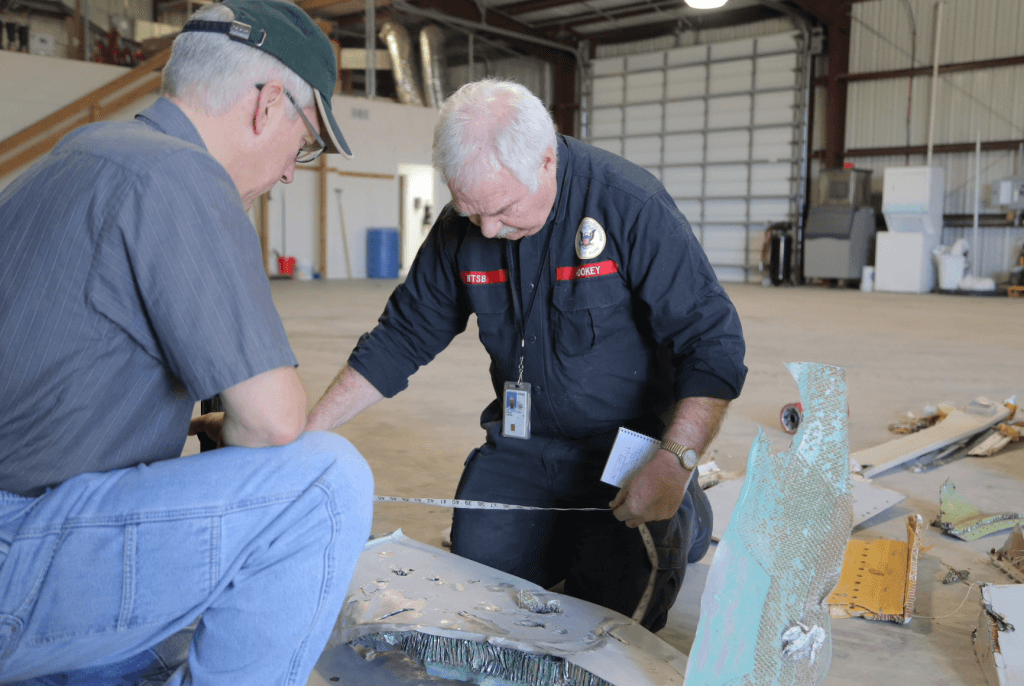 NTSB senior investigator Jim Hookey (on right) with Dan Kemme of GE aviation, examines wreckage recovered from the scene of the Feb. 23, 2019, cargo jet crash in Texas | NTSB
NTSB senior investigator Jim Hookey (on right) with Dan Kemme of GE aviation, examines wreckage recovered from the scene of the Feb. 23, 2019, cargo jet crash in Texas | NTSB
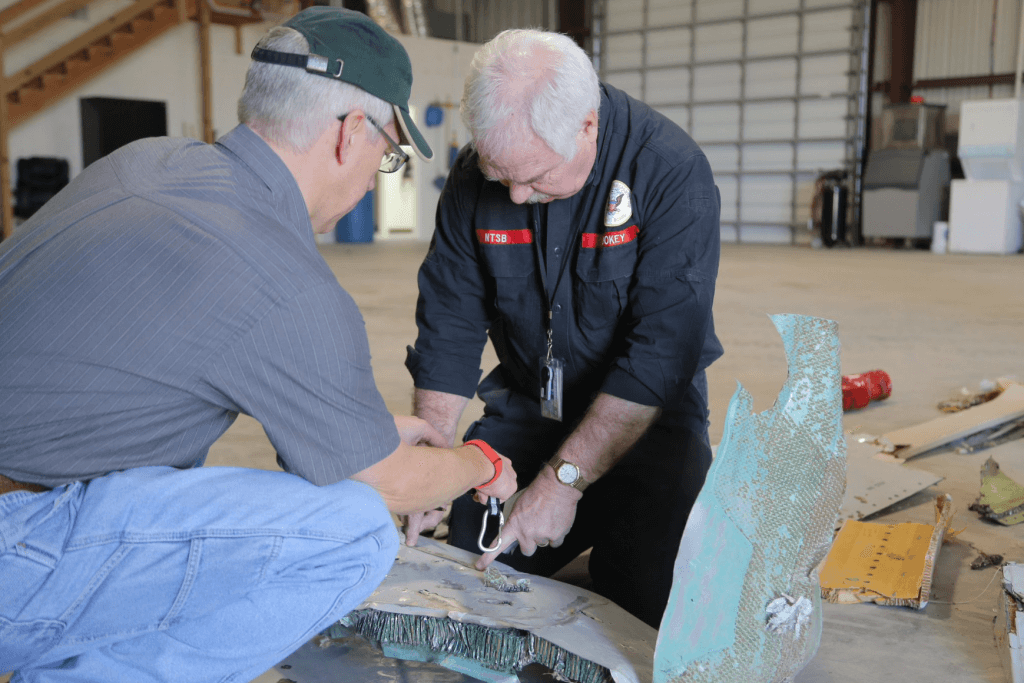
[UPDATE 6]
[UPDATE 7]
According to the NTSB, the aircraft was on a standard arrival route from the southeast. At 12.30 local time, the pilots contacted Houston Approach Control as they were descending through approx 18,000 feet, about 73 NM southeast of the airport. ATC advised there was light to heavy rain ahead and provided vectors around the weather. At 12.36, flight 3591 was cleared to descend to 3,000 feet. At 12.39, when the aircraft was at approximately 6,000 feet, contact was lost with the Boeing 767 Freighter.
Atlas Air Flight 3591 Air Traffic Control CommunicationsThe NTSB has located video footage from the Chambers County Jail security cameras showing the aircraft for approximately 5 seconds in a steep descent, a steep nose-down attitude.
[UPDATE 8]
The NTSB announced in social media that it will not hold a media briefing today (February 25th) on the Atlas Air flight 3591 crash in Texas. The statement said that additional information will be released as it becomes available.
Capt. Joe DePete, president of the Air Line Pilots Association, International, released the following statement regarding the Atlas Air Flight 3591 accident:
“I know I speak for every ALPA pilot in expressing a deep sense of sadness at the tragic loss of Atlas Air Flight 3591. Our thoughts are with the families, friends, and colleagues of the three pilots on board, including a Mesa Airlines pilot who was jumpseating on the flight.
“Our Air Safety Organization pilot volunteers and ALPA’s professional staff have reached out to support our union brothers and sisters at Atlas Air and Mesa Airlines through our Critical Incident Response Program (CIRP) as well as other resources.
“As with every aviation accident or incident, the sole focus of all concerned must be on allowing the authorities to conduct a thorough investigation and avoid speculation until any and all factors that may have been involved can be fully identified and evaluated.”
[UPDATE 9 | February 26, 2019]
The NTSB continues its ongoing investigation of the Feb 23, 2019, crash of an Atlas Air Boeing 767 Freighter in Texas.
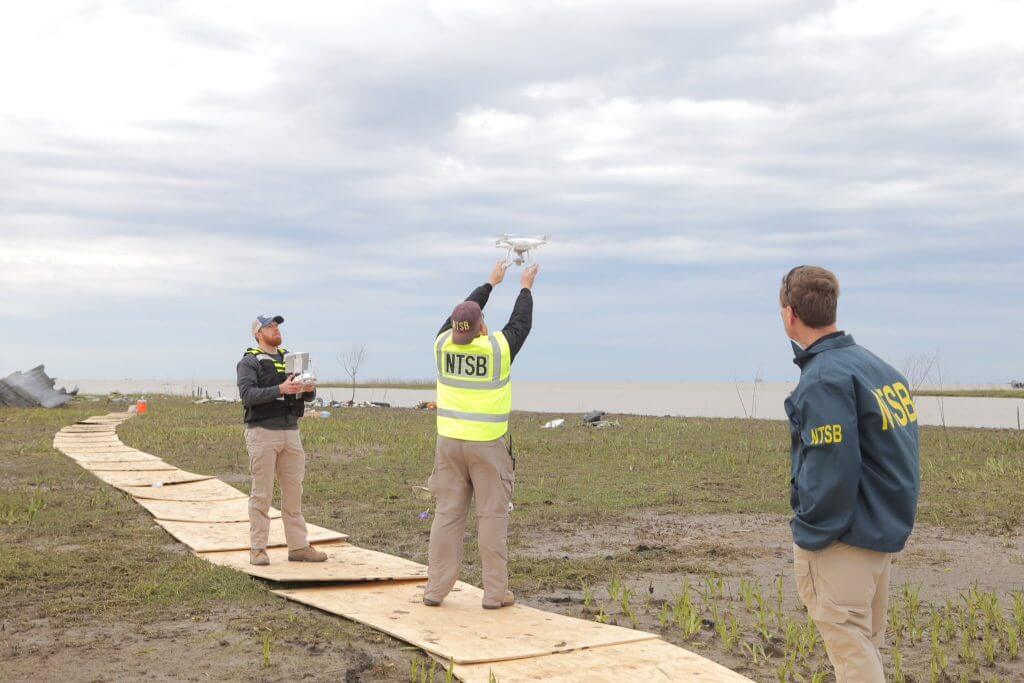 NTSB investigators launching a drone to survey debris field of the Feb. 23, 2019, cargo jet crash in Texas | NTSB
NTSB investigators launching a drone to survey debris field of the Feb. 23, 2019, cargo jet crash in Texas | NTSB
 NTSB investigators on shoreline of Trinity Bay examining wreckage from the Feb. 23, 2019 cargo jet crash in Texas | NTSB
NTSB investigators on shoreline of Trinity Bay examining wreckage from the Feb. 23, 2019 cargo jet crash in Texas | NTSB
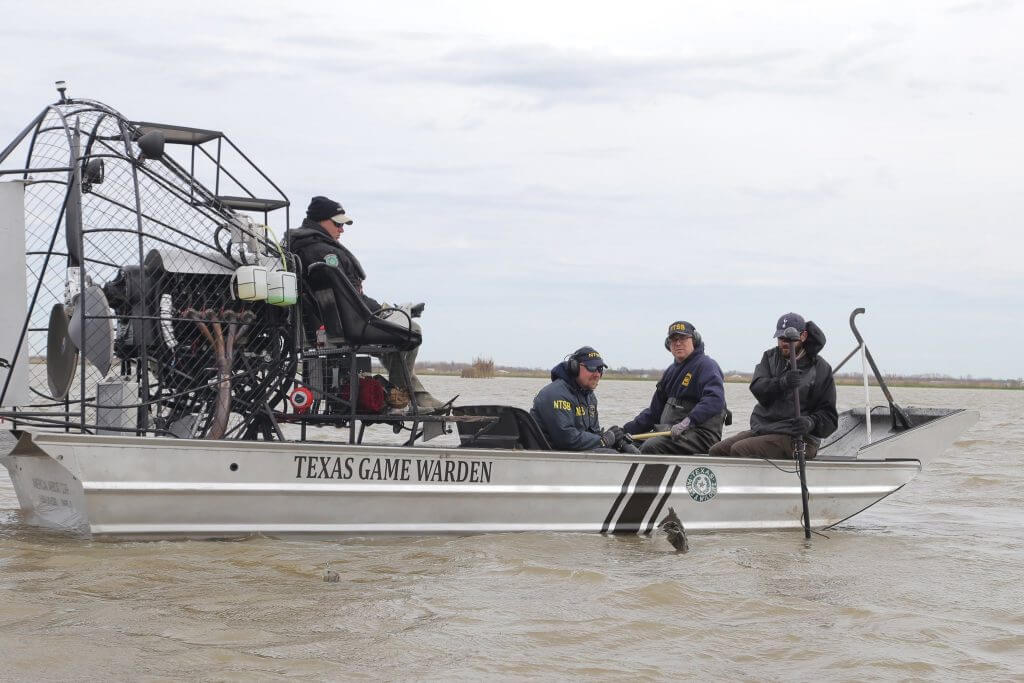 NTSB investigators along with representatives from Boeing and Texas Game Warden searching Trinity Bay for recorders from the cargo jet crash in Texas using pinger locator equipment to listen for the underwater locator beacon | NTSB
NTSB investigators along with representatives from Boeing and Texas Game Warden searching Trinity Bay for recorders from the cargo jet crash in Texas using pinger locator equipment to listen for the underwater locator beacon | NTSB
[UPDATE 10 | March 01, 2019]
The NTSB has recovered the cockpit voice recorder from the Atlas Air cargo jet that crashed in Trinity Bay in Anahuac, TX. The CVR is being transported to NTSB labs in Washington DC and will be evaluated when it arrives.
Teamsters Local 1224 president and Atlas Air Captain Daniel C. Wells made the following statement on the loss of the three pilots on board Atlas Air Flight 3591″
“Our union family is devastated and mourns the loss of our colleagues and crew members, Capt. Ricky Blakely and First Officer Conrad Jules Aska, and a fellow aviator from Mesa Airlines, pilot Sean Archuleta.
“Our thoughts and condolences go out to the families and friends of the three crew members involved. At this time we’re focused on doing everything we can to support them and to provide counseling to any pilots and their family members who are feeling the pain of this tremendous loss.”
President Wells, Executive Council Chairman Robert Kirchner and other officials, safety experts and volunteers from the union have been on the ground working with the NTSB, FAA, and local law enforcement supporting them in their investigation. The union mobilized its peer-to-peer Critical Incident Response Program (CIRP) immediately following the accident to support the pilots’ families and the broader union family with counseling and a 24-hour hotline.
[UPDATE 11 | March 05, 2019]
Engineers at the National Transportation Safety Board’s Office of Research and Engineering Vehicle Recorder Division completed the initial review of the Atlas Air Flight 3591 cockpit voice recorder Saturday evening and recovered the airplane’s flight data recorder Sunday.
Three people (the two pilots for the flight and a non-revenue jump-seat pilot) died when Atlas Air Flight 3591, a Boeing 767-300 cargo jet, crashed in the muddy marshland of Trinity Bay Feb. 23, 2019, about 40 miles from Houston’s George Bush Intercontinental Airport. The airplane was destroyed. The airplane was carrying cargo for Amazon.com Inc., and the US Postal Service from Miami to Houston.
The condition of the accident site made locating the recorders challenging.
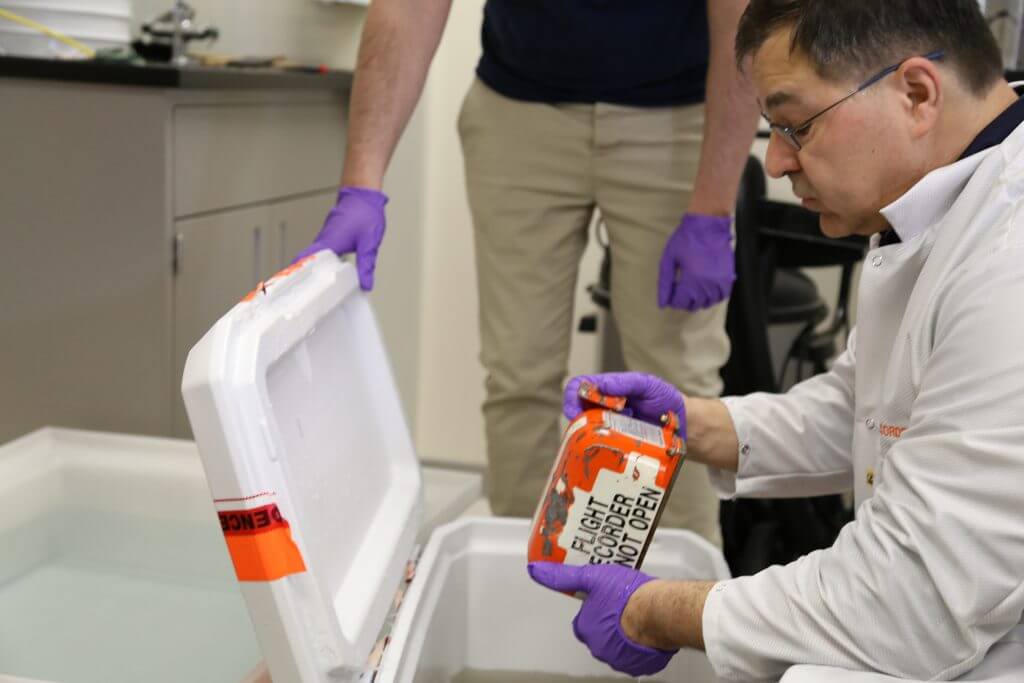 NTSB engineer Joe Gregor removing cockpit voice recorder from cooler used to transport from accident scene | NTSB
NTSB engineer Joe Gregor removing cockpit voice recorder from cooler used to transport from accident scene | NTSB
Directors from the Office of Research and Engineering and the Office of Aviation Safety conducted an audition of the CVR as part of the NTSB’s ongoing investigation of the accident. The audition revealed the following information, which is preliminary and subject to change as the investigation continues:
- The length of the recording is approximately two hours and was obtained from a download of a solid-state type cockpit voice recorder.
- The recording included the final portion of the flight; however, the quality of the audio is poor.
- There are times during the recording when the content of crew discussion is difficult to determine, at other times the content can be determined using advanced audio filtering.
- The crew was in communication with air traffic control and were being provided radar vectors for the runway 26L approach into George Bush Intercontinental Airport.
- Crew communications consistent with a loss control of the aircraft began approximately 18 seconds prior to the end of the recording.
 Memory boards from the cockpit voice recorder of Atlas Air Flight 3591 are inspected for signs of damage and water intrusion by an NTSB engineer | NTSB
Memory boards from the cockpit voice recorder of Atlas Air Flight 3591 are inspected for signs of damage and water intrusion by an NTSB engineer | NTSB
The flight data recorder arrived at the NTSB’s Recorder Lab Sunday at 11:45 p.m. The memory module was disassembled, cleaned and dried, and download of the data was achieved Monday afternoon. Initial review of the data revealed:
- The accident flight was captured, and the FDR contained a total of about 54 hours of data from 17 flights.
- There were approximately 350 parameters recorded by the FDR detailing the motion of the aircraft and operation of its engines, flight controls and other systems.
NTSB recorder investigators are currently verifying and validating the FDR data, and the NTSB plans to provide a summary in an investigative update in a few days.
 Flight data recorder of Atlas Air Flight 3591 being disassembled and inspected by an NTSB engineer | NTSB
Flight data recorder of Atlas Air Flight 3591 being disassembled and inspected by an NTSB engineer | NTSB
Technical experts in the CVR group will convene in the coming week to review the entire recording and produce a transcript of the accident recording. It will be a time-consuming process to complete the transcript.
The CVR group is one of the seven investigative groups established by the Investigator-in-Charge for the accident investigation.
[UPDATE 12 | March 12, 2019]
The NTSB issued an investigative update on the Atlas Air flight 3591 that crashed about 40 miles from Houston’s George Bush Intercontinental Airport.
On February 23, 2019, at 1239 central standard time, Atlas Air flight 3591, a Boeing 767-375BCF, N1217A, entered a rapid descent from 6,000 ft and impacted a marshy bay area about 40 miles southeast of George Bush Intercontinental Airport (KIAH), Houston, Texas. The two pilots and one nonrevenue jumpseat pilot were fatally injured. The airplane was destroyed and highly fragmented. The airplane was operated as a Title 14 Code of Federal Regulations Part 121 domestic cargo flight, which originated from Miami International Airport (KMIA), Miami, Florida, and was destined for KIAH.
The NTSB launched a go-team consisting of an investigator-in-charge from the major investigations division and specialists in structures, systems, powerplants, air traffic control (ATC), and meteorology. Specialists in operations, human factors, maintenance records, and flight recorders supported the investigation from other locations.
Parties to the investigation include the Federal Aviation Administration (FAA), Atlas Air, General Electric (GE) Aviation, Boeing, the International Brotherhood of Teamsters, and the National Air Traffic Controllers Association. The investigative team was also assisted by numerous other federal, state, and local law enforcement and public safety agencies.
The wreckage was situated in a shallow muddy swamp area, and the main debris field was oriented east to west and about 350 yards long by about 200 yards wide (figure 1). One engine and some landing gear components were found beyond the main debris field to the west. Less dense components and a large portion of the cargo floated southward and were recovered up to 20 miles away. The wreckage was highly fragmented and resting in the soft mud in 1-3 ft of water. Recovery of the wreckage was very difficult in the swampy conditions because visibility in the water was poor and the muddy bottom could not support heavy equipment. Airboats, barges, and amphibious equipment was brought in to search for the recorders and retreive the wreckage.
 Aerial view of main debris field during recovery operation.
Aerial view of main debris field during recovery operation. Airboat in top center is retrieving the CVR at the time of this photo. | NTSB
Air traffic control communications and radar data indicated the flight was normal from Miami to the Houston terminal area. About 12:30 pm the pilots contacted the Houston terminal radar approach control (TRACON) arrival controller and reported descending for runway 26L; the airplane was at 17,800 ft with a ground speed 320 knots.
At 12:34, the airplane was descending through 13,800 ft, and the controller advised of an area of light to heavy precipitation along the flight route and that they could expect vectors around the weather.
 National Weather Service NEXRAD weather, white star is accident site | NTSB
National Weather Service NEXRAD weather, white star is accident site | NTSB
About 12:35, the flight was transferred to the Houston TRACON final controller, and the pilot reported they had received the Houston Automatic Terminal Information System weather broadcast. The controller told the pilots to expect vectors to runway 26L and asked if they wanted to go to the west or north of the weather.
Radar data indicated the airplane continued the descent through 12,000 ft with a ground speed of 290 knots, consistent with the arrival procedure. The pilots responded that they wanted to go to the west of the area of precipitation. The controller advised that to do so, they would need to descend to 3,000 ft expeditiously.
About 12:37, the controller instructed the pilots to turn to a heading of 270°. Radar data indicated the airplane turned, and the automatic dependent surveillance-broadcast (ADS-B) data indicated a selected heading of 270°. The airplane was descending through 8,500 ft at this time.
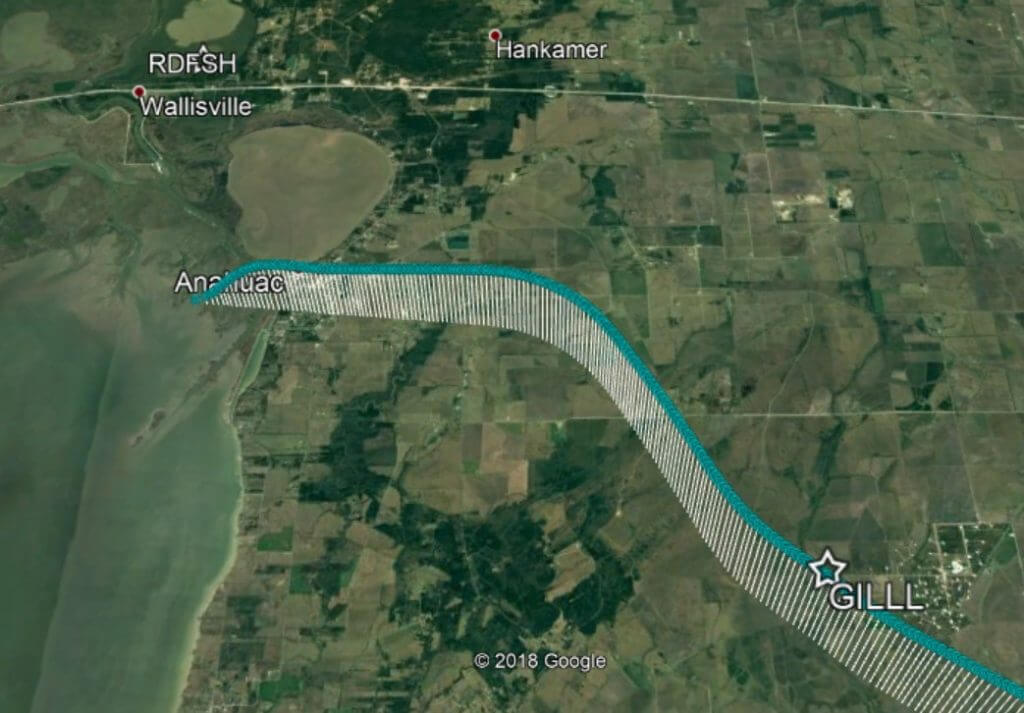 ADS-B track | NTSB
ADS-B track | NTSB
About 12:38, the controller informed the pilots that they would be past the area of weather in about 18 miles, that they could expect a turn to the north for a base leg to the approach to runway 26L, and that weather was clear west of the precipitation area. The pilots responded, “sounds good” and “ok.” At this time, radar and ADS-B returns indicated the airplane leveled briefly at 6,200 ft and then began a slight climb to 6,300 ft.
Also, about this time, the FDR data indicated that some small vertical accelerations consistent with the airplane entering turbulence. Shortly after, when the airplane’s indicated airspeed was steady about 230 knots, the engines increased to maximum thrust, and the airplane pitch increased to about 4° nose up. The airplane then pitched nose down over the next 18 seconds to about 49° in response to nose-down elevator deflection. The stall warning (stick shaker) did not activate.
FDR, radar, and ADS-B data indicated that the airplane entered a rapid descent on a heading of 270°, reaching an airspeed of about 430 knots. A security camera video (figure 4) captured the airplane in a steep, generally wings-level attitude until impact with the swamp. FDR data indicated that the airplane gradually pitched up to about 20 degrees nose down during the descent.
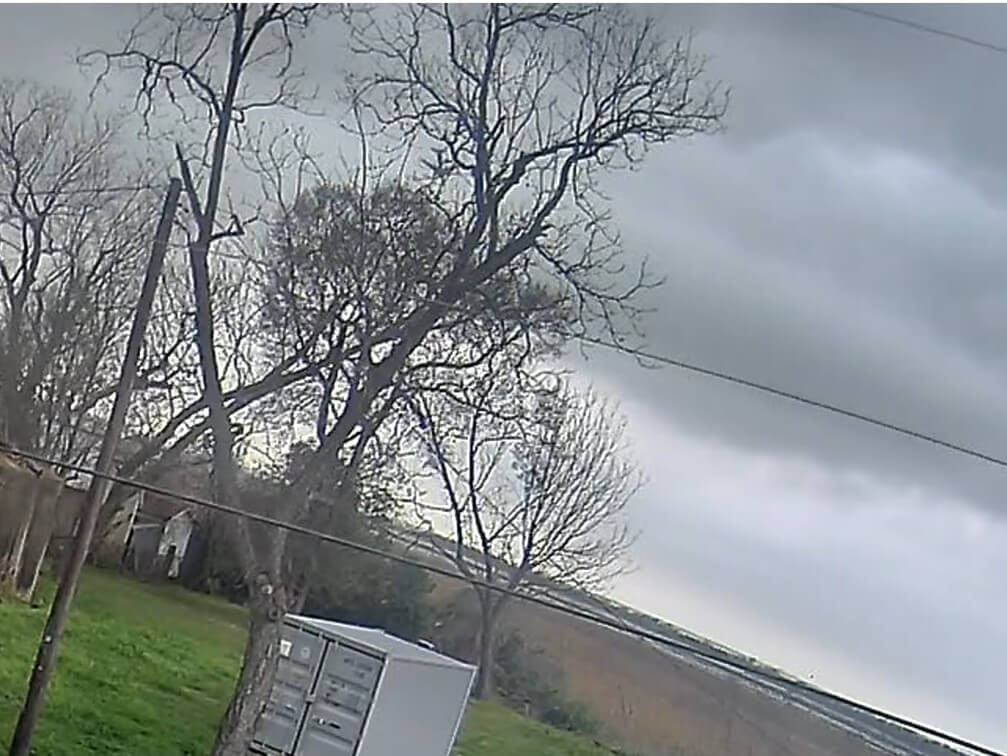 Still frame from security video | NTSB
Still frame from security video | NTSB
The airplane was manufactured in 1992 as a Boeing 767-375 in a passenger configuration and was equipped with GE CF-6 engines. It was converted to a freighter configuration in 2017. Maintenance records showed the airplane had 91,063 hours and 23,316 cycles at the time of the accident. There were no outstanding airworthiness directives or inoperative items.
Company records indicated that the captain was qualified and current in the airplane and held an FAA airline transport pilot certificate with type ratings for the B757/767 and EMB145. He had a current FAA first-class medical certificate with a limitation for corrective lenses. He had worked for Atlas Air since September 2015 and had about 11,000 hours total flight experience with about 1,250 hours of experience in the Boeing 767.
The first officer was qualified and current in the airplane and held an FAA airline transport pilot certificate with type ratings for the B757/767, EMB145, and EMB170/190. He had a current FAA first-class medical certificate with a limitation for glasses for near vision. He had worked for Atlas Air since July 2017 and had about 5,000 hours total flight experience with about 520 hours of experience in the Boeing 767.
A cockpit voice recorder (CVR) group was convened and will complete a transcript of the entire event. The CVR transcript will be released when the public docket is opened. Other groups include operations/human factors, ATC, weather, structures, systems, powerplants, and maintenance records. Further groups may be formed as the investigation progresses.

